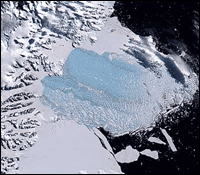Entered into the database on Saturday, August 06th, 2005 @ 19:06:40 MST
In the spring of 2002, a large chunk of the Larsen B ice shelf (LIS-B) on the
Antarctic Peninsula broke off and tumbled into the Weddell Sea. A new analysis
published today in the journal Nature suggests that the more than 3,200 square
kilometer area that collapsed signifies an unprecedented loss in the past 10,000
years and can be attributed to accelerated climate warming in the region. Eugene Domack of Hamilton College and his colleagues studied six sediment cores
collected from the area around the ice shelf as well as other data, such as temperature
and salinity measurements of the Weddell Sea. The results indicate that LIS-B
has been stable since the Late Pleistocene to Holocene transition, which occurred
11,500 years ago. The ice shelf had been thinning slowly, however, which was evidenced
by a change in the oxygen isotopes present in plankton preserved from the underlying
water column. The team calculates that the glacier thinned by a few tens of meters
over the course of thousands of years Local temperatures on the Antarctic Peninsula, meanwhile, have risen by about
two degrees Celsius over the past 50 years, an increase that is more pronounced
than in other regions of the world. The authors write that their observation that
the modern collapse of the LIS-B is a unique event supports the hypothesis that
the current warming trend in the northwestern Weddell Sea is longer and bigger
than past warm episodes. Together with the slow thinning, it was this prolonged
period of warming that led to LIS-B's collapse, they conclude.
